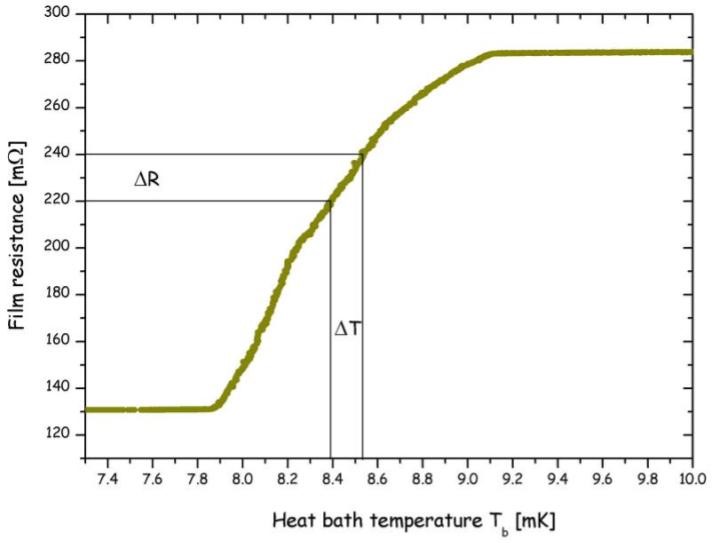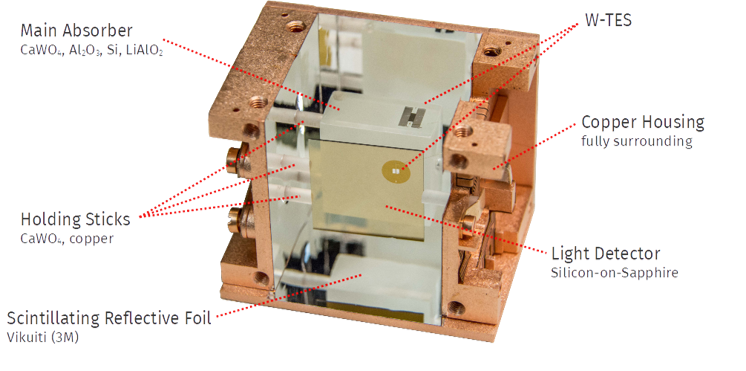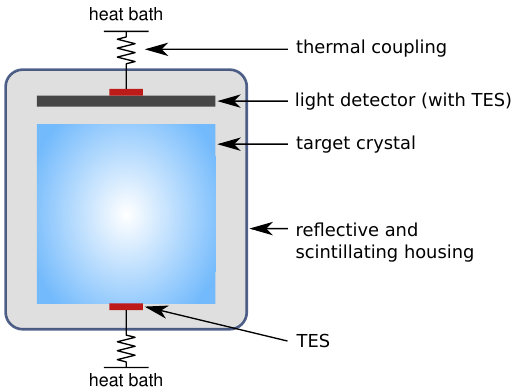Cryogenic Detectors
The idea behind this type of detector is quite simple: if some amount of energy is deposited in a crystal, then its temperature will increase by a certain amount which is given by the heat capacity. On a microscopic level, temperature can be seen as a movement of the atoms in the crystal lattice - the higher the temperature, the faster the atoms move around their fixed position in the crystal. This implies that there is a lowest temperature when all atoms are standing still. This absolute zero is the zero-point of the Kelvin temperature scale where 0 K corresponds to -273.15 C.
When going close to this absolute zero temperature, the tiniest amount of movement induced by a particle hitting an atom in the detector will cause a dramatic measurable temperature increase, which would not be noticeable at room temperature. But even then, the typical amount of energy expected from a dark matter interaction only causes a temperature increase of a millionth of a degree. This requires a very sensitive device to detect temperature changes.
One such device is a so-called transition edge sensor (TES). These consist of a thin film of a material that becomes superconducting below a certain critical temperature. This means that below that critical temperature, an electric current can flow through the material without resistance and above the critical temperature, the material behaves as a normal electric conductor with an ohmic resistance.
The transition between the superconducting and normal conducting state happens in a very narrow temperature region, in which the electrical resistance increases rapidly with increasing temperature. If one now stabilizes the thin superconducting film at a temperature within this narrow transition region with a heater, each small temperature increase leads to a sudden measurable increase in resistance which can be read out as voltage pulses with sensitive electronics.

Particle Discrimination
With CRESST-II, the simultaneous read-out of the deposited energy in the main absorber and an associated light signal was introduced to identify and suppress backgrounds due to radioactive contaminations. This required the change from sapphire absorbers to a scintillating absorber material.
Scintillation is the property of a material to emit light when radiation or highly energetic particles are absorbed. Related phenomena are fluorescence and phosphorescence which are known from glow-in-the-dark toys or the glowing effect under black light. After some research, CaWO4 was chosen as the default material. It has several desirable properties:
- high scintillation light output at low temperatures
- high density
- large atomic number, which enhances the expected event rate in some scenarios
The CaWO4 main absorbers are then paired with a second cryogenic detector which detects the scintillation light. These light detectors are typically made from a thin sapphire wafer with a thin layer of Si to enhance the light absorption.

For each signal in the main absorber a small fraction (few percent) of the deposited energy is emitted in the form of scintillation light. The interesting thing is that the precise amount of light produced depends on the interaction type. The light output is highest for beta or gamma events which form the majority of unwanted background events while for nuclear recoils - like the dark matter signals we are looking for - the light output is much lower. This effect is called quenching and allows us to distinguish between signal-like nuclear recoil events and other background events. It is even possible to some extent to identify whether the recoiling nucleus is calcium, tungsten or oxygen based on the characteristic light output.
We typically display our data in the energy vs. light yield plane, where the energy measured by the main absorber is plotted on the x-axis and the light yield - the ratio between the energy in the light detector and the main absorber - is plotted on the y-axis. The different event types then show up as distinct bands in this plane. The width of these bands is given by the amount of light produced at each energy and the energy resolution of the light detector. At lower energies, the bands overlap completely, because for none of the interactions we see a significant light signal.

CRESST Detector Modules
Over the years the design of CRESST detector modules has evolved based on our experience and depending on the WIMP mass range we are focussing on. CRESST-I started out with cubic sapphire absorbers, CRESST-II continued with cylindrical CaWO4 absorbers and CRESST-III went back to smaller cuboid absorbers using a variety of different materials. Besides these standard designs, various other geometries have been tested throughout the years.
CRESST-II Modules
CRESST-II modules consist of a cylindrical CaWO4 crystal that has a diameter and height of 40mm and weighs about 300g. This is paired with a circular light detector. They are held with flexible bronze clamps in a light-tight copper housing. To maximize the light collection, the module is clad with a highly reflective foil which is itself scintillating. This allows us to identify background events due to radioactive decays happening on the surfaces of the absorber crystal or the foil.

CRESST-II Detector Module.
CRESST-III Modules
In CRESST-III detectors, the size of the main absorber is reduced to (20 x 20 x 10) mm3 which for CaWO4 results in a mass of ~25g. This lowers the heat capacity, meaning that less energy is needed to cause the same temperature increase because less material needs to be heated up. The dimensions of the light detector are adjusted accordingly to (20 x 20 x 0.4) mm3.
Both the main absorber and light detector are now held by CaWO4 sticks to avoid direct contact with the bronze clamps, which were identified as a source of dangerous nuclear recoil background events. They are encased again in a light-tight copper housing covered on the inside with the highly reflective foil.
Other notable designs
One interesting design idea involves a beaker shaped light detector made from silicon that surrounds the entire main absorber. This enhances the light collection by covering all but one side of the crystal with the active light detector. This also allows to identify background events originating from the surfaces as they should cause simultaneous signals in both detectors. To also identify such events from the "open" side of the beaker, the main absorber is glued to a so-called carrier crystal. Events in the carrier crystal and the main absorber can be distinguished via their different pulse shapes. The remaining challenge is to lower the energy threshold down to which this discrimination is possible to be comparable with the threshold of the standard modules.

Drawing of a CRESST detector - standard design.
